Front Matter
Preface
Table of Contents
2. Review of Radar Range Performance Computations
2.1 General Radar Range Equation
2.2 Radar Detection with Noise Jamming or Interference
2.3 Beacon and Repeater Equations
2.4 Bistatic Radar
2.5 Radar Detection Equations in Distributed Clutter Volume Reflectors for Pulse Radars
2.6 Pulse-Radar Detection Equations for Area Clutter
3. Statistical Relationships for Various Detection Processes
3.1 Introduction and Definitions
3.2 Target Detection by a Pulsed Radar
3.3 Additional Results of the Marcum and Swerling Analysis
3.4 Noncoherent Integration Losses
3.5 Postdetection Integration with Partially Correlated Noise
3.6 Independent Sampling of Clutter Echoes
3.7 Digital Integrators and Limits on Independent Sampling
3.8 Cumulative Detection of a Radar Target
3.9 Detection Range for an Approaching Target
3.10 Summary
4. Automatic Detection by Nonlinear, Sequential, and Adaptive Processes
4.1 Introduction
4.2 Dynamic Range Problems-STC and IAGC
4.3 Effects of Limiters on Target Detection
4.4 Effects of Interfering Signals in Systems with Limiters
4.5 Limiting in Pulse Compression and Pulse Doppler Systems
4.6 Summary of Limiter Effects
4.7 Sequential Detection and Track-Before-Detect Processing
4.8 Adaptive Threshold Techniques
4.9 Dynamic Range of Rayleigh Signals
4.10 Overall False Alarm Control
5. Radar Targets
5.1 General Scattering Properties-Simple Shapes
5.2 Polarization Scattering Matrix
5.3 Complex Targets-Backscatter and Distributions
5.4 Measured Aircraft and Missile RCS Distributions
5.5 Missile and Satellite Cross Sections
5.6 Marine Targets
5.7 Miscellaneous Airborne Reflections and Clear Air Echoes
5.8 Spectra of Radar Cross-Section Fluctuations
5.9 Frequency-Agility Effects on Target Detection and Tracking
5.10 Bistatic Radar Cross Section of Targets
6. Atmospheric Effects, Weather, and Chaff
6.1 Standard Atmospheric Attenuation
6.2 Precipitation Occurrence and Extent
6.3 Attenuation in Hydrometeors and Foliage
6.4 Backscatter Coefficient of Rain, Snow, and Clouds
6.5 Radar Precipitation Doppler Spectra
6.6 Frequency Correlation of Precipitation Echoes
6.7 Spatial Uniformity of Rain Backscatter
6.8 Tropospheric Refraction Effects
6.9 General Properties of Chaff
6.10 Spectra of Chaff Echoes
7. Sea and Land Backscatter
7.1 Backscatter from the Sea-Monostatic
7.2 Empirical Sea Backscatter Models for Low Grazing Angles
7.3 Sea Clutter near Vertical Incidence
7.4 Polarization and Wind-Direction Effects on Reflectivity
7.5 Spectrum of Sea Clutter Echoes
7.6 Spatial and Frequency Correlation of Sea Clutter
7.7 Short-Pulse Sea Clutter Echoes or Spikes
7.8 Sea Clutter under Ducting Conditions
7.9 Short-Range Clutter
7.10 Backscatter from Various Terrain Types
7.11 Composite Terrain at Low Grazing Angles
7.12 Composite Terrain at Mid-Angles
7.13 Composite Terrain-Spatial and Temporal Distributions
7.14 Bistatic Sea and Land Clutter
8. Signal-Processing Concepts and Waveform Design
8.1 Radar Requirements as We Approach the Year 2000
8.2 Matched Filters
8.3 The Radar Ambiguity Function
8.4 The Radar Environmental Diagram
8.5 Optimum Waveforms for Detection in Clutter
8.6 Desirability of Range-Doppler Ambiguity
8.7 Classes of Waveforms
8.8 Digital Representation of Signals
9. Moving Target Indicators MTI
9.1 MTI Configurations
9.2 Limitations on MTI Performance-Clutter Fluctuations
9.3 Digital MTI Limitations
9.4 Noncoherent and Nonlinear Processes
9.5 Ambiguous-Range Clutter
9.6 Airborne MTI
9.7 System Limitations
10. Environmental Limitations of CW Radars
10.1 Transmitter Spillover and Noise Limitations
10.2 CW, FM-CW, and ICW Transmissions
10.3 Rain Clutter Power for Separate Transmit and Receive Antennas
10.4 Sea and Land Clutter Power for Surface Antennas
10.5 Clutter Spectrum for Airborne Radars
11. Pulse Doppler and Burst Waveforms
11.1 Terminology and General Assumptions
11.2 Range Doppler Limitations
11.3 Ambiguity Diagrams for Single-Carrier Pulse Trains
11.4 Amplitude, Phase, and Pulse-Width Tapering of Finite Pulse Trains
11.5 Block Diagrams for Pulse Doppler Receivers
11.6 Fast Fourier Transform Processing
11.7 Architecture for Pulse-Train Processors
11.8 Range Computations for Pulse Doppler Radars
11.9 Clutter Computations
11.10 Truncated Pulse Trains
11.11 Summary
12. Phase-Coding Techniques
12.1 Principles of Phase Coding
12.2 The Barker, MPS, and Other Useful Codes
12.3 Random and Maximal-Length Pseudorandom Codes
12.4 Sidelobe Suppression of Phase-Coded Words
12.5 Polyphase-Coded Words
12.6 Compression Techniques-All-Range Compressors
12.7 Cross Correlators and Tracking Techniques
12.8 Phase-Coded Words-Noise and Clutter Performance
13. Frequency-Modulated Pulse Compression Waveforms
13.1 Multiplicity of Frequency-Modulation Techniques
13.2 Linear FM Pulses Chirp
13.3 Generation and Decoding of FM Waveforms
13.4 Distortion Effects on Linear FM Signals
13.5 Spectrum of a Comb of Frequencies
13.6 Waveform Analysis for Discrete Frequencies
13.7 Capabilities for Extreme Bandwidths and "Stretch" Techniques
13.8 Resolution Properties of Frequency-Coded Pulses
13.9 Sidelobe Reduction
13.10 Pulse Compression Decoders and Limiter Effects
13.11 Nonlinear FM
13.12 Ambiguity Diagrams for FM Waveforms
13.13 Digital Decoders
14. Hybrid Processors, Meteorological Radar, and System Performance Analysis
14.1 The Moving Target Detector MTD
14.2 Meteorological Radar
14.3 Aerostat Surveillance Radars
14.4 Performance Estimation for Coherent Pulse Radars
Bibliography and References
Index
A
B
C
D
E
F
G
H
I
J
K
L
M
N
O
P
Q
R
S
T
U
V
W

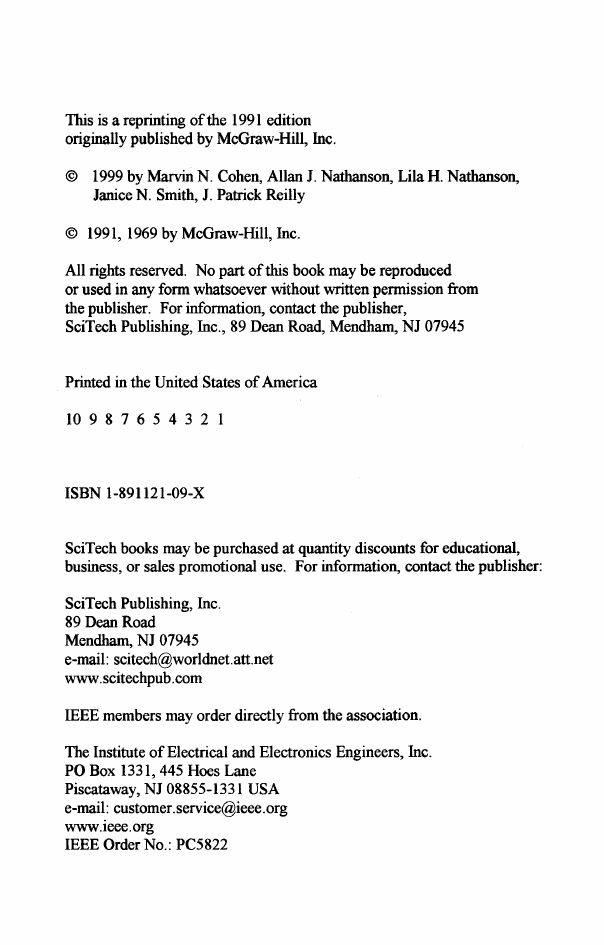
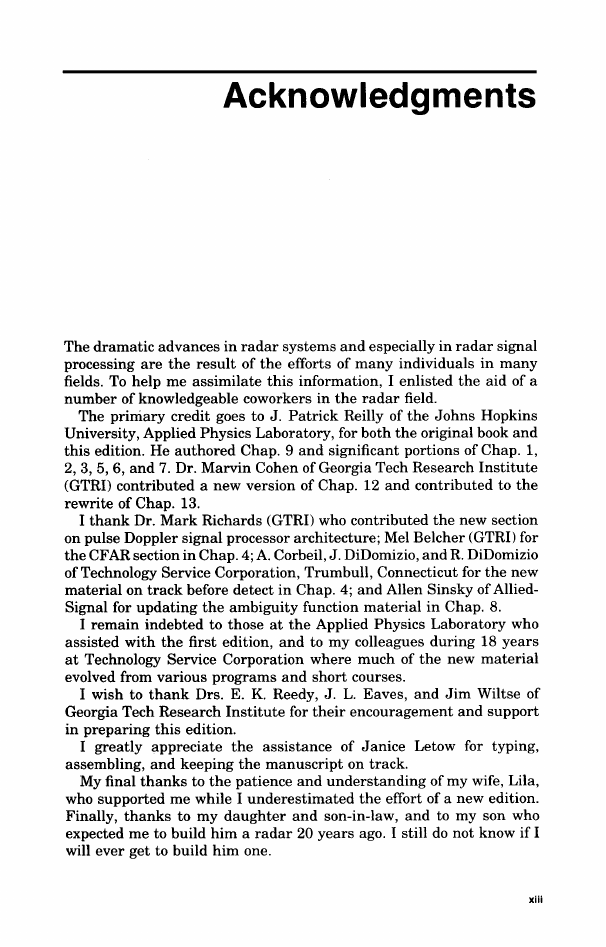
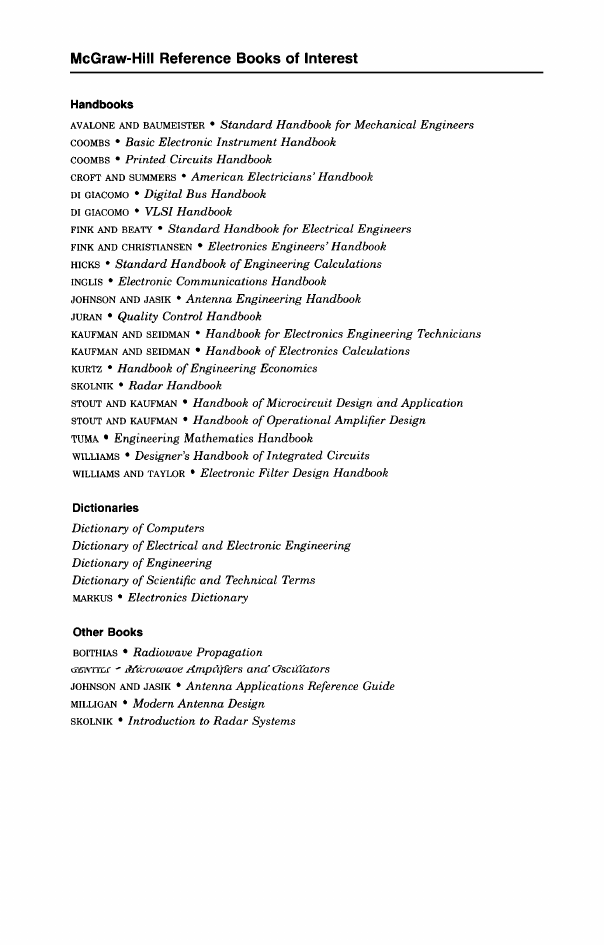
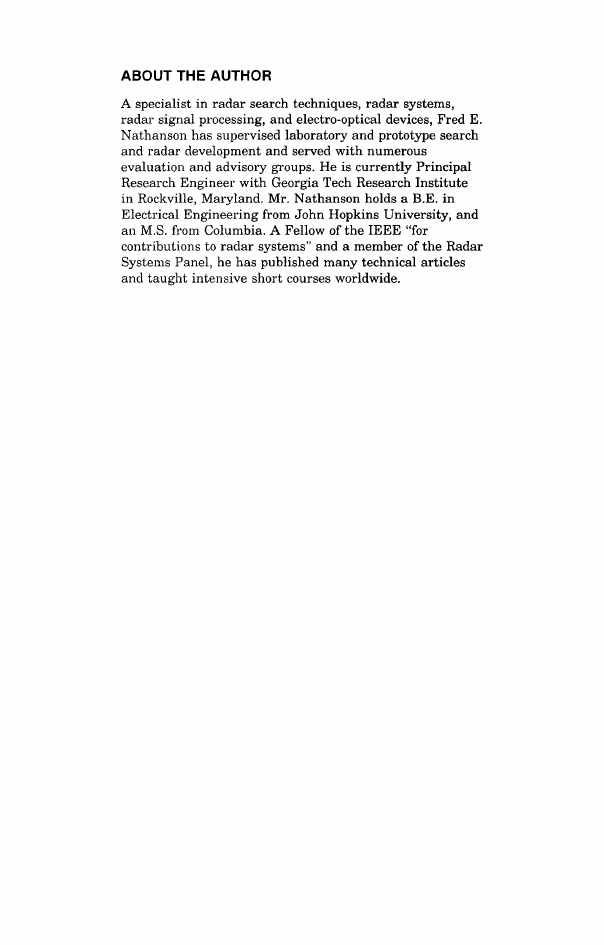

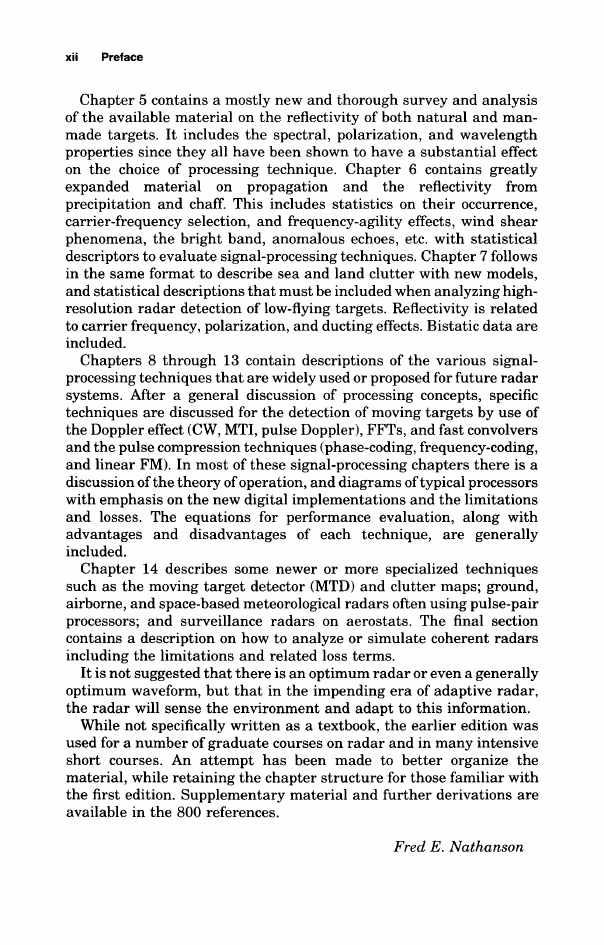
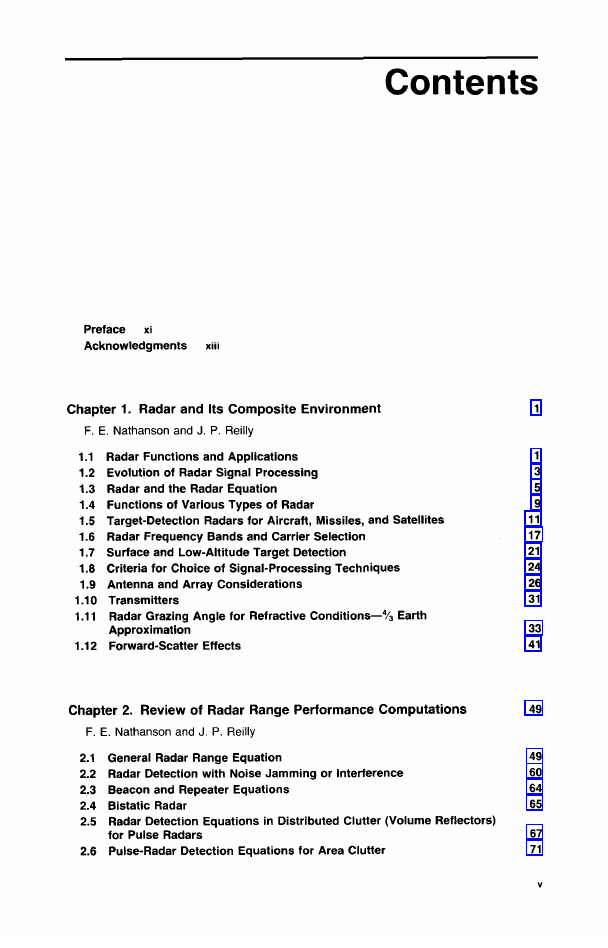








 2023年江西萍乡中考道德与法治真题及答案.doc
2023年江西萍乡中考道德与法治真题及答案.doc 2012年重庆南川中考生物真题及答案.doc
2012年重庆南川中考生物真题及答案.doc 2013年江西师范大学地理学综合及文艺理论基础考研真题.doc
2013年江西师范大学地理学综合及文艺理论基础考研真题.doc 2020年四川甘孜小升初语文真题及答案I卷.doc
2020年四川甘孜小升初语文真题及答案I卷.doc 2020年注册岩土工程师专业基础考试真题及答案.doc
2020年注册岩土工程师专业基础考试真题及答案.doc 2023-2024学年福建省厦门市九年级上学期数学月考试题及答案.doc
2023-2024学年福建省厦门市九年级上学期数学月考试题及答案.doc 2021-2022学年辽宁省沈阳市大东区九年级上学期语文期末试题及答案.doc
2021-2022学年辽宁省沈阳市大东区九年级上学期语文期末试题及答案.doc 2022-2023学年北京东城区初三第一学期物理期末试卷及答案.doc
2022-2023学年北京东城区初三第一学期物理期末试卷及答案.doc 2018上半年江西教师资格初中地理学科知识与教学能力真题及答案.doc
2018上半年江西教师资格初中地理学科知识与教学能力真题及答案.doc 2012年河北国家公务员申论考试真题及答案-省级.doc
2012年河北国家公务员申论考试真题及答案-省级.doc 2020-2021学年江苏省扬州市江都区邵樊片九年级上学期数学第一次质量检测试题及答案.doc
2020-2021学年江苏省扬州市江都区邵樊片九年级上学期数学第一次质量检测试题及答案.doc 2022下半年黑龙江教师资格证中学综合素质真题及答案.doc
2022下半年黑龙江教师资格证中学综合素质真题及答案.doc